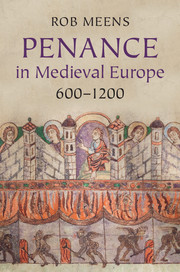Book contents
- Frontmatter
- Dedication
- Contents
- List of Figures
- Acknowledgments
- 1 Introduction
- 2 The late antique legacy
- 3 A new beginning? Penitential practice in the insular world
- 4 Insular texts on the move: penance in Francia and England
- 5 Penance and the Carolingian Reforms
- 6 New penitential territories: the tenth and eleventh centuries
- 7 The twelfth century
- Conclusion
- Appendix 1 The manuscripts of Theodore’s penitential
- Appendix 2 The manuscripts of the Excarpsus Cummeani
- Appendix 3 The manuscripts of the Bede and Egbert penitentials
- Appendix 4 The manuscripts of Halitgar’s penitential
- Sources
- Bibliography
- General index
- Manuscript index
- References
1 - Introduction
Published online by Cambridge University Press: 05 August 2014
- Frontmatter
- Dedication
- Contents
- List of Figures
- Acknowledgments
- 1 Introduction
- 2 The late antique legacy
- 3 A new beginning? Penitential practice in the insular world
- 4 Insular texts on the move: penance in Francia and England
- 5 Penance and the Carolingian Reforms
- 6 New penitential territories: the tenth and eleventh centuries
- 7 The twelfth century
- Conclusion
- Appendix 1 The manuscripts of Theodore’s penitential
- Appendix 2 The manuscripts of the Excarpsus Cummeani
- Appendix 3 The manuscripts of the Bede and Egbert penitentials
- Appendix 4 The manuscripts of Halitgar’s penitential
- Sources
- Bibliography
- General index
- Manuscript index
- References
Summary
In the late seventh century an anonymous compiler of a penitential handbook included the following phrase: ‘If someone [is] a magician and is able to provoke storms, he should do penance for seven years, three on bread and water.’ This short sentence can be an entrance into a world in which farmers fear for their crops because of heavy hail and thunderstorms and try to protect them by supernatural means. Some people, in the sources of the period referred to as tempestarii, a term that one could translate as ‘stormmakers’, apparently played on these fears and offered protection against such meteorological disasters in return for material rewards. A treatise composed by the ninth-century bishop of Lyon, Agobard, arguing against such beliefs, provides a useful background to this penitential canon. Agobard describes a belief in magical ships travelling through the sky coming from a land called Magonia and communicating with tempestarii as to where to land their ship, provoking a heavy storm and robbing the land of its crops by taking these aboard the ship. Farmers gave the tempestarii a material reward, which they called the canonicum, so Agobard informs us, and used this fact as an excuse not to pay the tithe that they owed the church. Thanks to Agobard’s treatise the terse formulation of the penitential text cited above reveals a broader context, yet there still remain unsolved riddles. One of these concerns the question who these tempestarii were. Were they pagan priests competing with Christian clerics, as has recently been maintained? Or are we dealing with independent village sorcerers, who were nominally Christian, yet dabbled in sorcery and witchcraft? One could even argue that Agobard was combatting Christian priests or monks offering liturgical protection against thunderstorms. The small number of source materials from this period makes it hard to provide definite answers to basic questions. Penitential texts do provide essential information regarding these ways to ward off bad weather, but it is hard to reach any definitive solutions. As we shall see, such uncertainty also characterizes the debate about medieval penance, particularly in the earlier period before c. 1200.
- Type
- Chapter
- Information
- Penance in Medieval Europe, 600–1200 , pp. 1 - 11Publisher: Cambridge University PressPrint publication year: 2014



